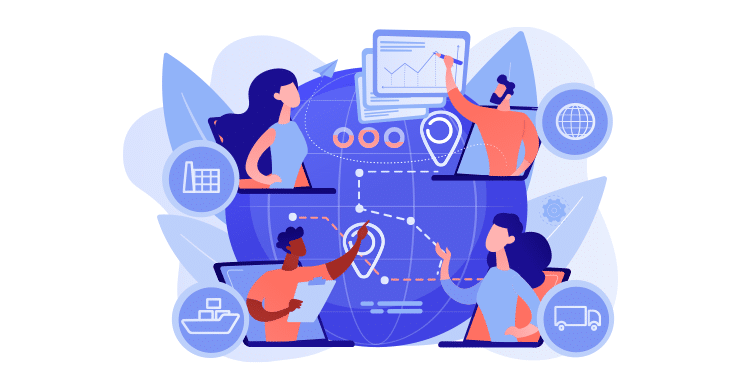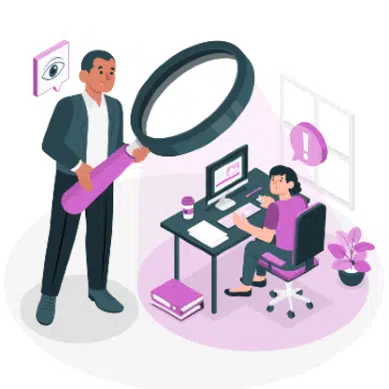What is a Supply Chain?
A supply chain is composed of multiple companies, vendors, and suppliers all working together to produce products or services. Global supply chain risks have been a growing threat for a long time, but have spiked significantly in the past few years, putting management teams on their toes regarding the next major attack. The complexity and lack of visibility into global supply chains can make it difficult for organizations to develop an effective supply chain risk management strategy.

What are Supply Chain Security Risks?
Let’s take a closer look at the supply chain to further understand the security risks it invites.
In the past, the technological link between a business and its system manufacturers systems may have been limited to shipping-related communications. Now, it is not uncommon to share more data and grant higher access levels to streamline complex global supply chains.
The result is a potential backdoor into your system by third parties. A vulnerability along a supply chain creates a door of entry for a malicious actor. The goal of supply chain risk management is to identify and prevent these risks.
The Need for Supply Chain Risk Management
Supply Chain Risk Management (SCRM) is the process of identifying and monitoring the risks and mitigation processes of a company’s supply chain. Managing and monitoring supply chain risk is a top priority in today’s hyper-connected world, and can ensure business continuity in the face of global events.
Global suppliers and third-party vendors are in some ways as much a part of your business as your internal infrastructure. It’s important to remember that even if your vendors are properly vetted, their vendors may not be. Criminals know this. It’s why supply chain attacks are continually increasing year-over-year. Supply chain risk management is critical to your company’s future.
Start Getting Value With
Centraleyes for Free
See for yourself how the Centraleyes platform exceeds anything an old GRC
system does and eliminates the need for manual processes and spreadsheets
to give you immediate value and run a full risk assessment in less than 30 days
Examples of Supply Chain Risk
Supply chain risks can be viewed through a general lens or as they relate specifically to security.
General examples of supply chain risks include:
- Shortages of lack of supply
- Product quality
- Logistics and delivery
- High overhead
Security risks that stem from vendor and supply chain vulnerabilities can be significant. They include but are not limited to:
- Intellectual property theft
- Reputational damage
- Credential theft
- Data breach
- Network intrusion and malicious “insiders”
- Malware
Guide to Supply Chain Management
Identify and Understand Risks
First, you must understand which types of risk your suppliers present, as well as the severity of the risk. Assess each node of the supply chain, and enter risks on a register.
Calculate Risks and Assign Severity Ratings
Analyze and prioritize risks that reflect the organization’s risk appetite. Identify the highest-risk product lines and chain nodes with the greatest negative risk impact.
Managing supply chain risk requires the prioritization of higher risk over lower-risk vendors. Risk ratings will help you organize your risk-monitoring strategies. A good first step in calculating risk is putting a dollar amount to the risk impact. Also known as risk quantification, this method will help you understand which areas of your supply chain are most likely to cause a major business disruption. Potential reputational and regulatory risk exposures should be considered subsequently.
Monitor Risks
Persistent monitoring is key in supply chain risk management. Automated digital tools make this possible in even the most complex supply chains.
Monitoring will be successful when the process is customized to the business’s needs. One organization may emphasize quality assurance, while another business will need to monitor the weather to predict weather-related disruptions. An early warning system to track and monitor leading risks will give you the advantage in mitigating risk impact.
Oversight and Review
No management program will operate efficiently without robust governance and oversight. Business leaders that represent every node of the supply chain should meet periodically to review top risks, define strategies, and stay updated on evolving regulatory requirements.
How to Enhance Supply Chain Risk Governance
- Practice adequate due diligence before vendor onboarding
- Use identity access management (IAM) tools to make clear rules and roles as to who can log into your network, from where, and with which permissions.
- Visibility beyond third-party vendors is crucial for supply chain management. Third-party relationships should be subject to high standards of vetting their vendors (fourth-party risk management)
- Educate employees on the risks of the supply chain
Regulatory Requirements in Supply Chain Risk Management
NIST frameworks and ISO 27000 are no newcomers to supply chain risk management and have required controls in this area for quite some time. As recently as May 2022, NIST released an informative white paper with guidelines for supply chain risk management.
Other standards and regulatory frameworks are beginning to understand the importance of this risk and are expanding their demands to include more controls governing interaction with and use of vendors. A critical part of successful SCRM is maintaining your management policy, regularly assessing its effectiveness, and ensuring supply nodes are updated with all requirements.
Supply Chain Management Automation Solutions
An automated solution will enable businesses to manage all aspects of vendor risk management efficiently and optimally, and significantly improve their ability to reduce vendor risk. All the above-mentioned challenges can be tackled and triumphed using the power of automation.
Benefits of using technology to automate third-party risk management include:
- Increase the speed of identifying risks (thereby shortening the risk exposure time and quickening the mitigation response)
- Save hundreds of hours and resources automating security risk assessments
- Security questionnaire automation
- Measure the probability and impact of individual vendors or see them as a whole
- Actively scan vendor websites to identify and mitigate vulnerabilities
- See results in real-time, and watch the progress as it happens
- Data analysis and evaluation tools can be implemented for full visibility and easy assessment of results
- Produce reports detailing high- and low-level analysis of vendor risk posture for individual vendors and overall
- Keep vendors updated with regulations and compliance requirements
- Reduce human error
The Centraleyes Solution
With Centraleyes, you will empower your third and fourth-party relationships with tools to close security gaps and reduce risks by providing automated remediation steps for them to follow to fix any vulnerabilities or security flaws you find. Track progress and re-assess security posture in real-time.
Leverage all the capabilities of vendor risk and compliance automation with Centraleyes comprehensive risk management solution. Take a look at how we can arm you with the tools you need to build a robust supply chain risk management program.
Start Getting Value With
Centraleyes for Free
See for yourself how the Centraleyes platform exceeds anything an old GRC
system does and eliminates the need for manual processes and spreadsheets
to give you immediate value and run a full risk assessment in less than 30 days





